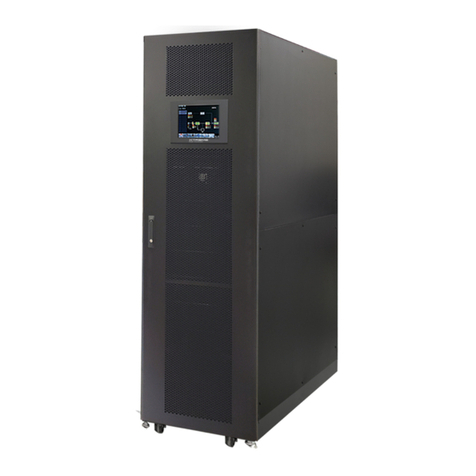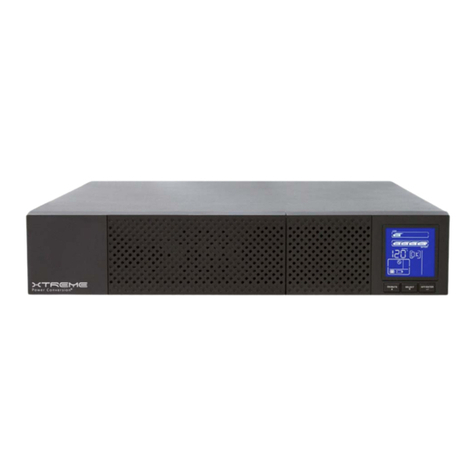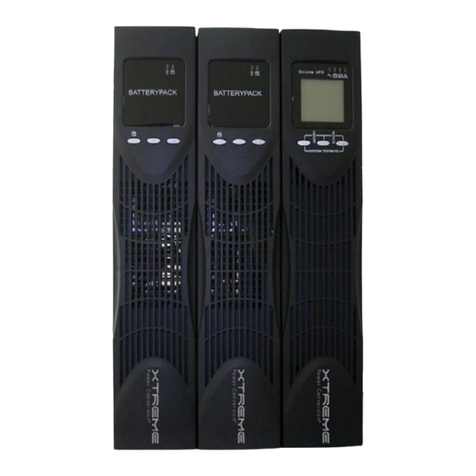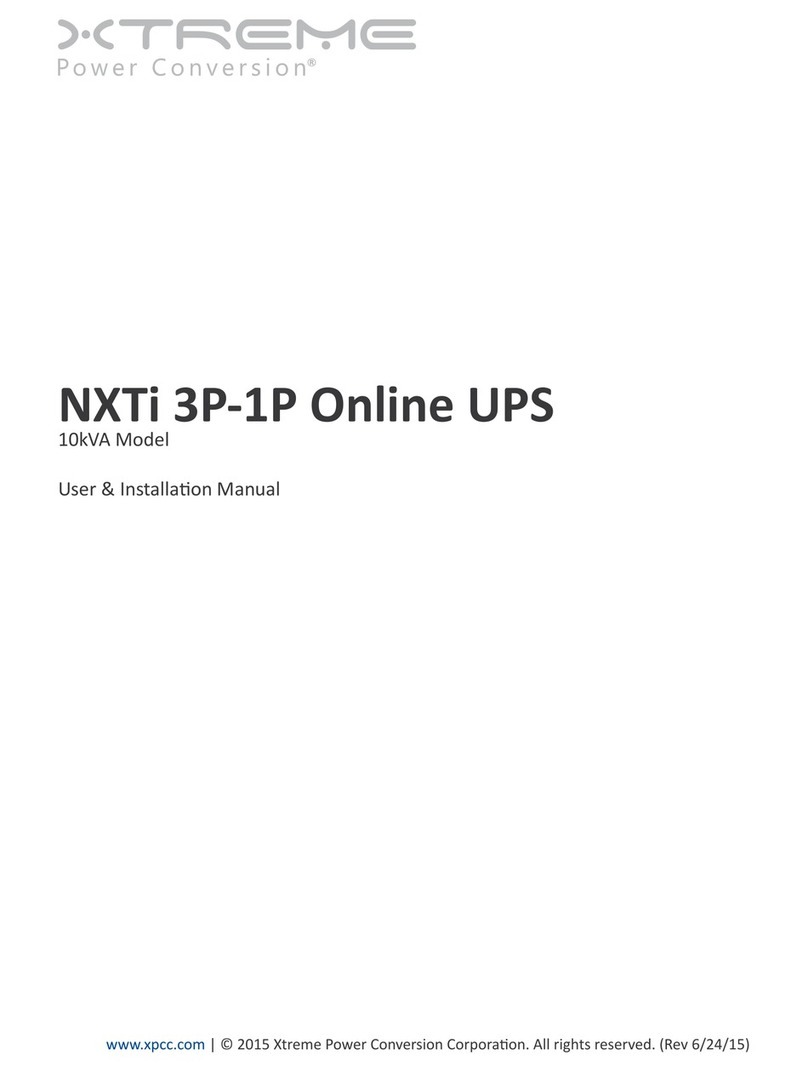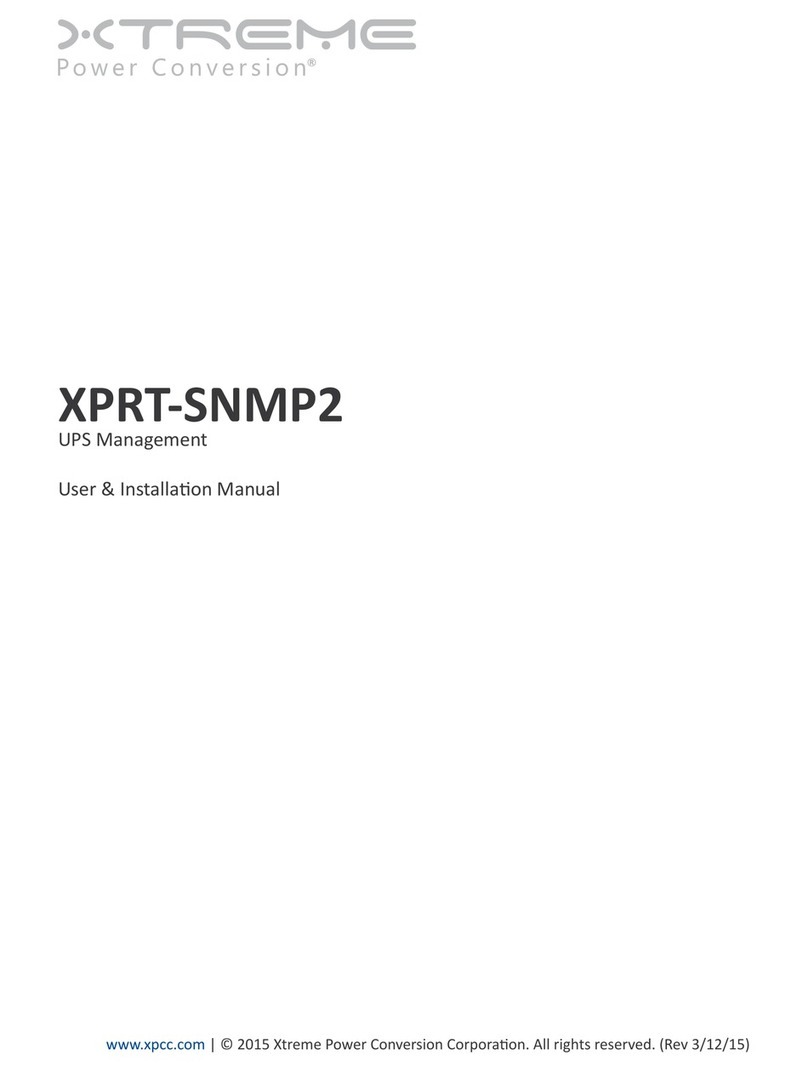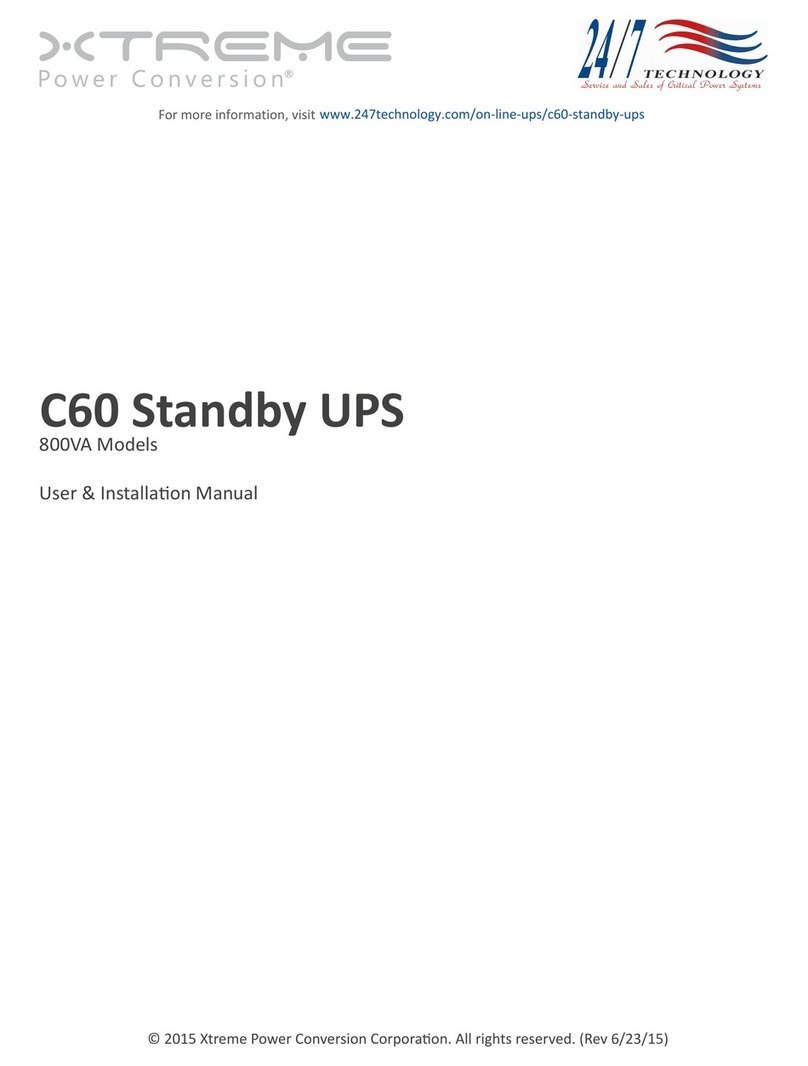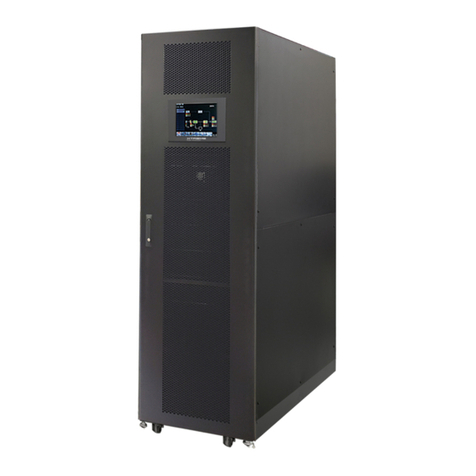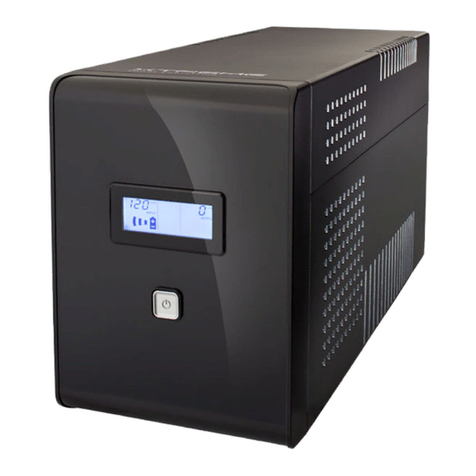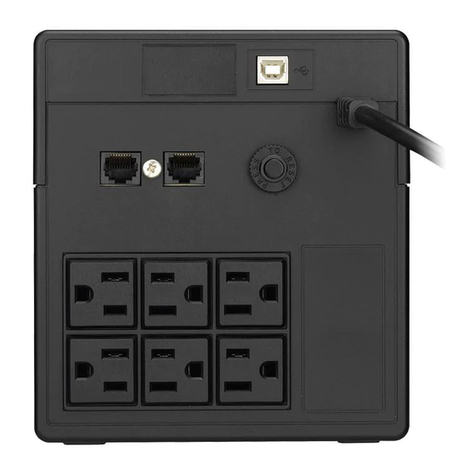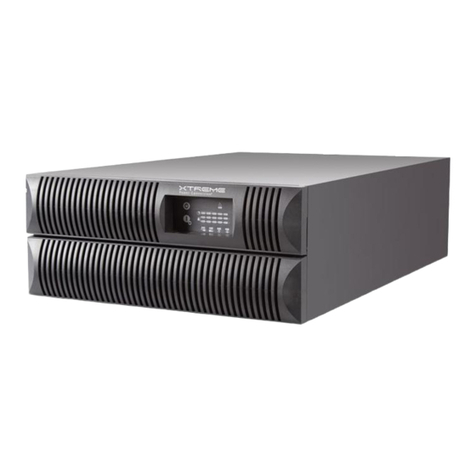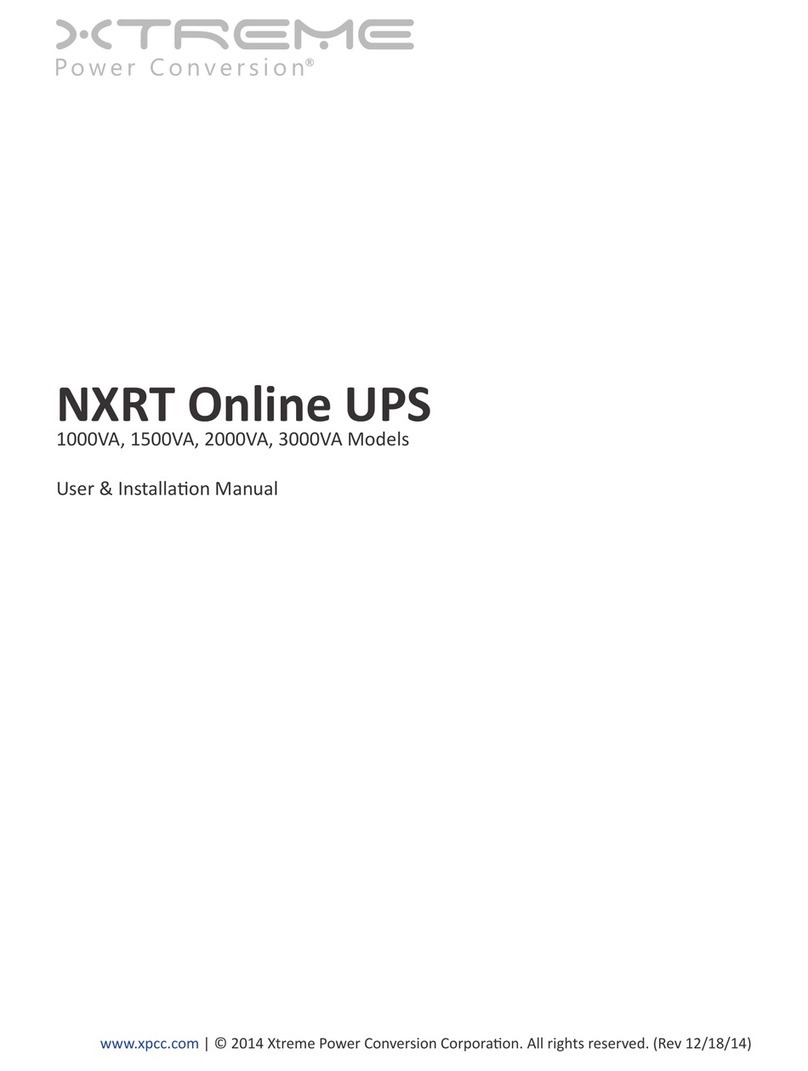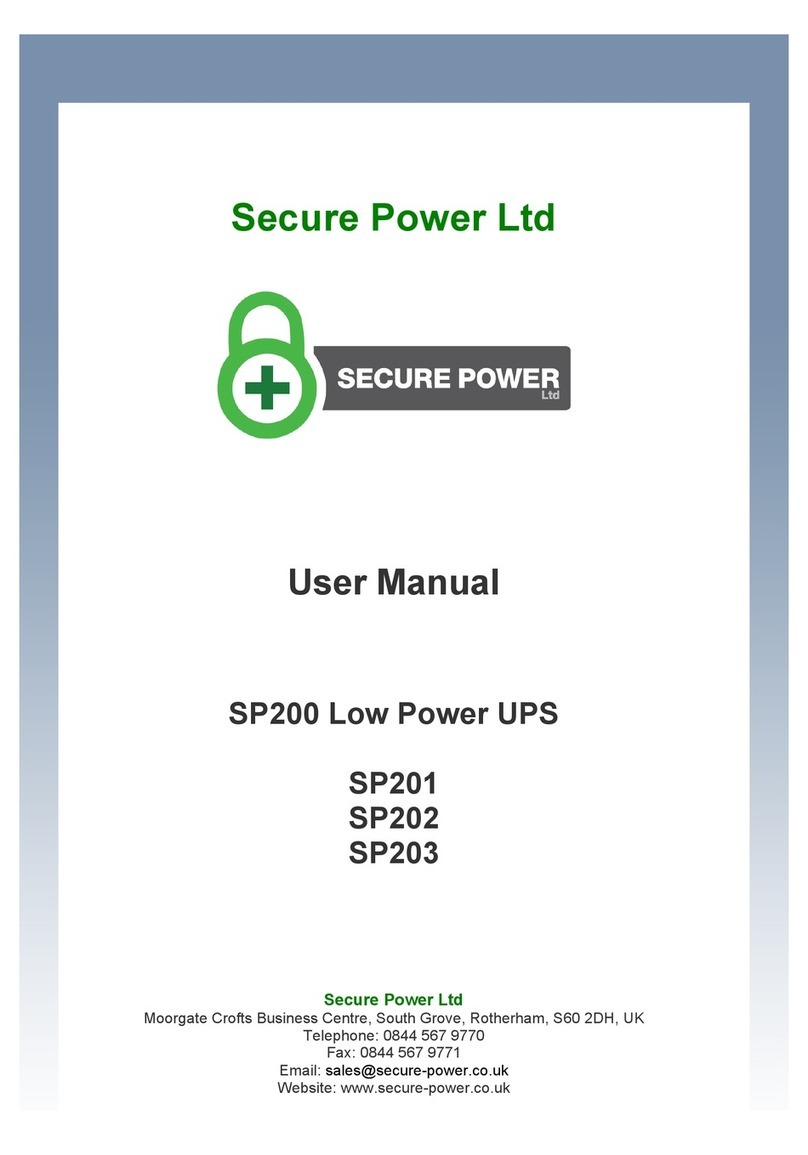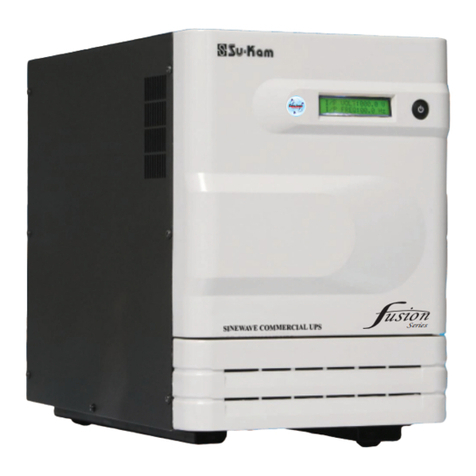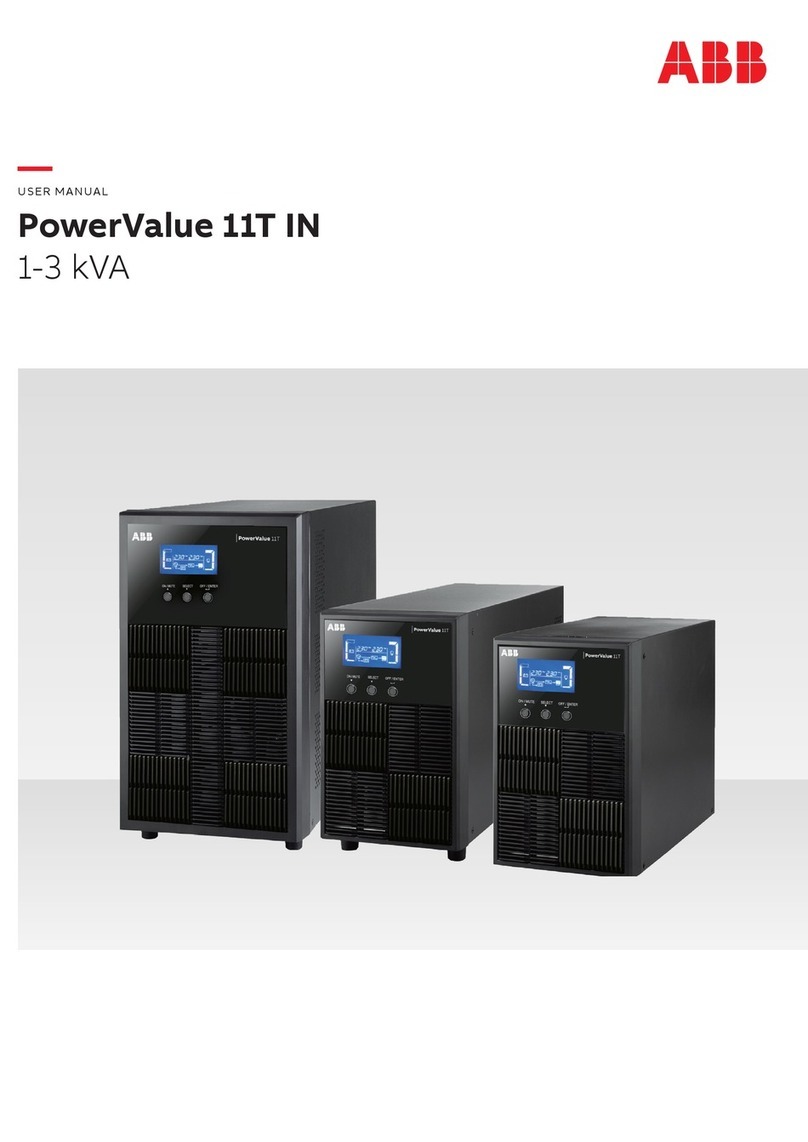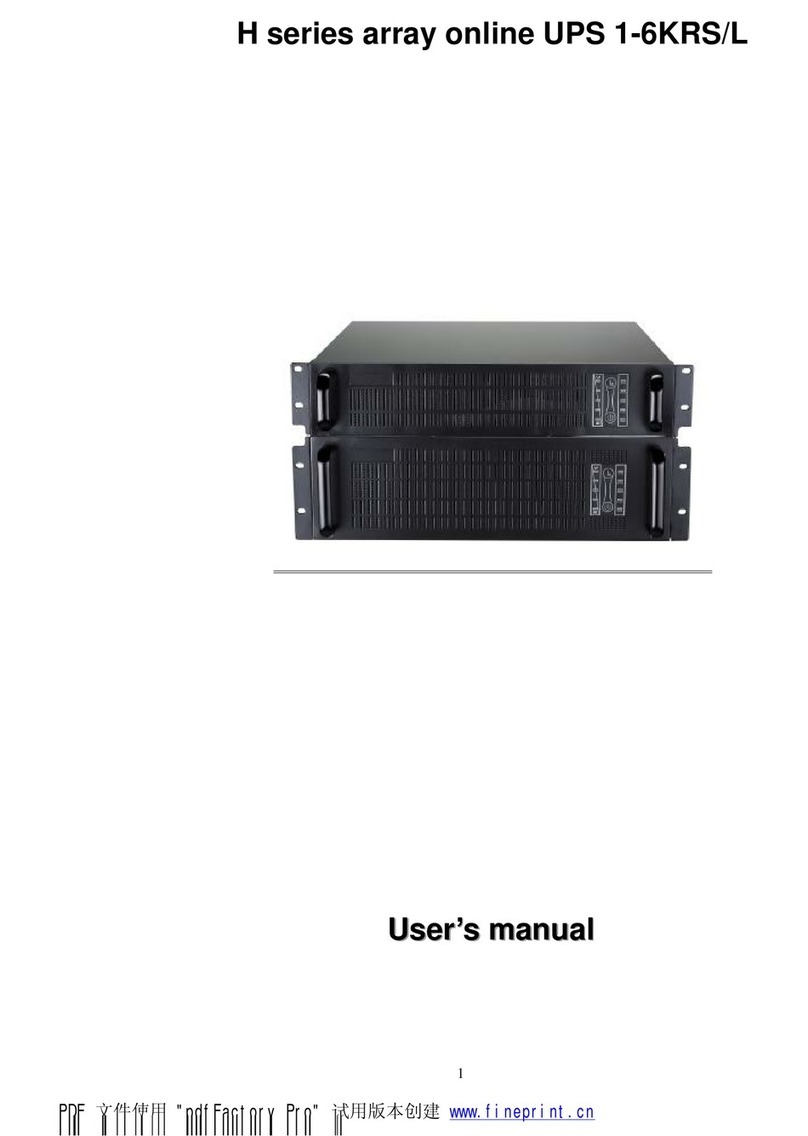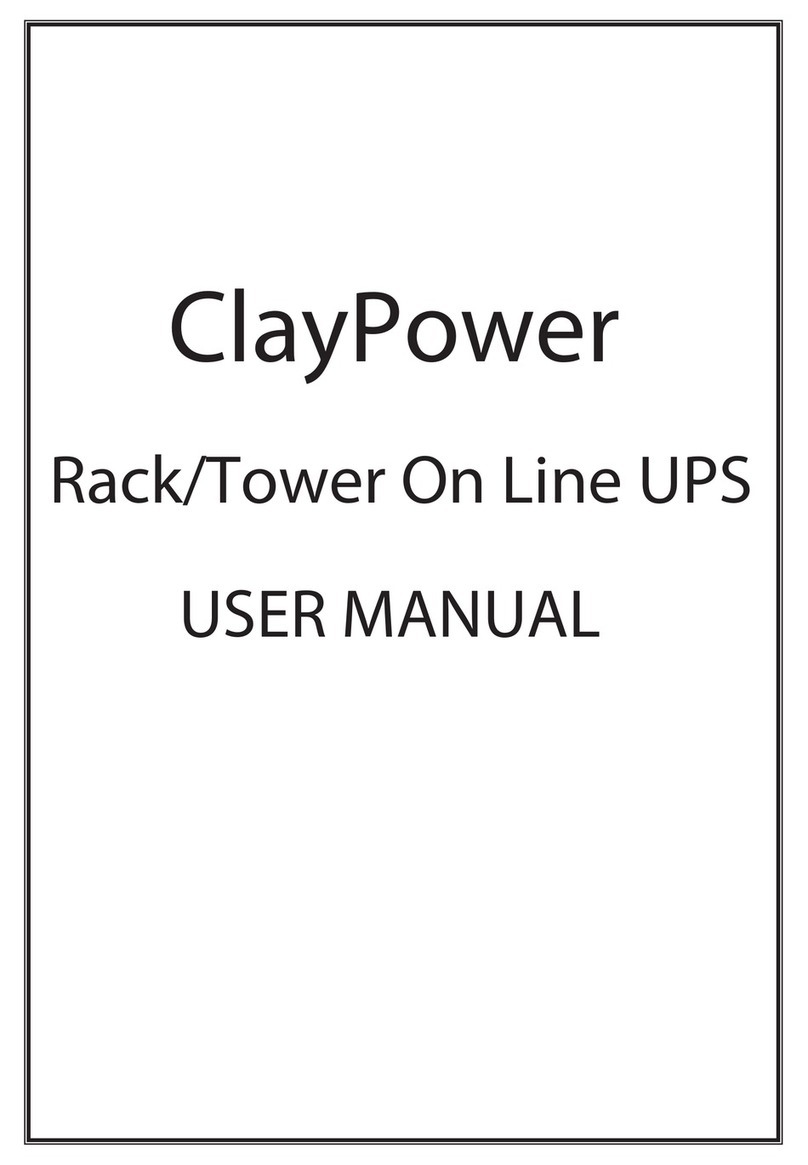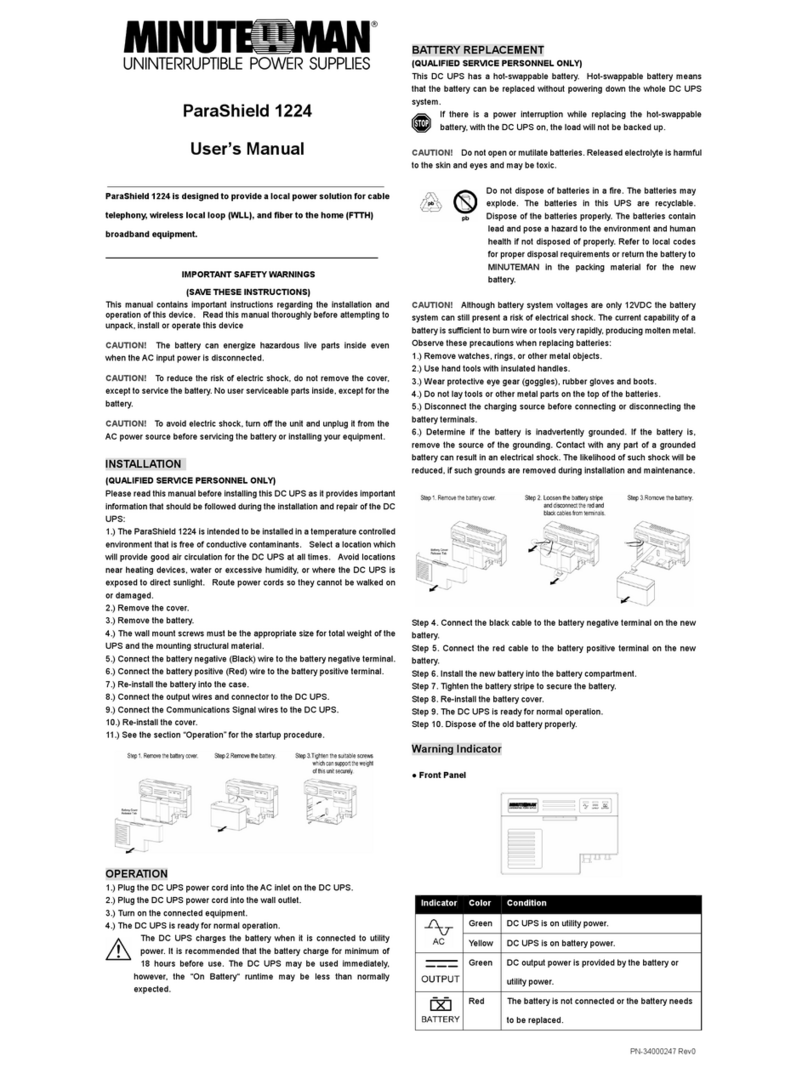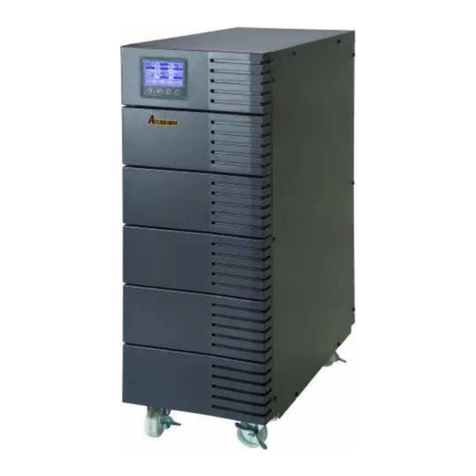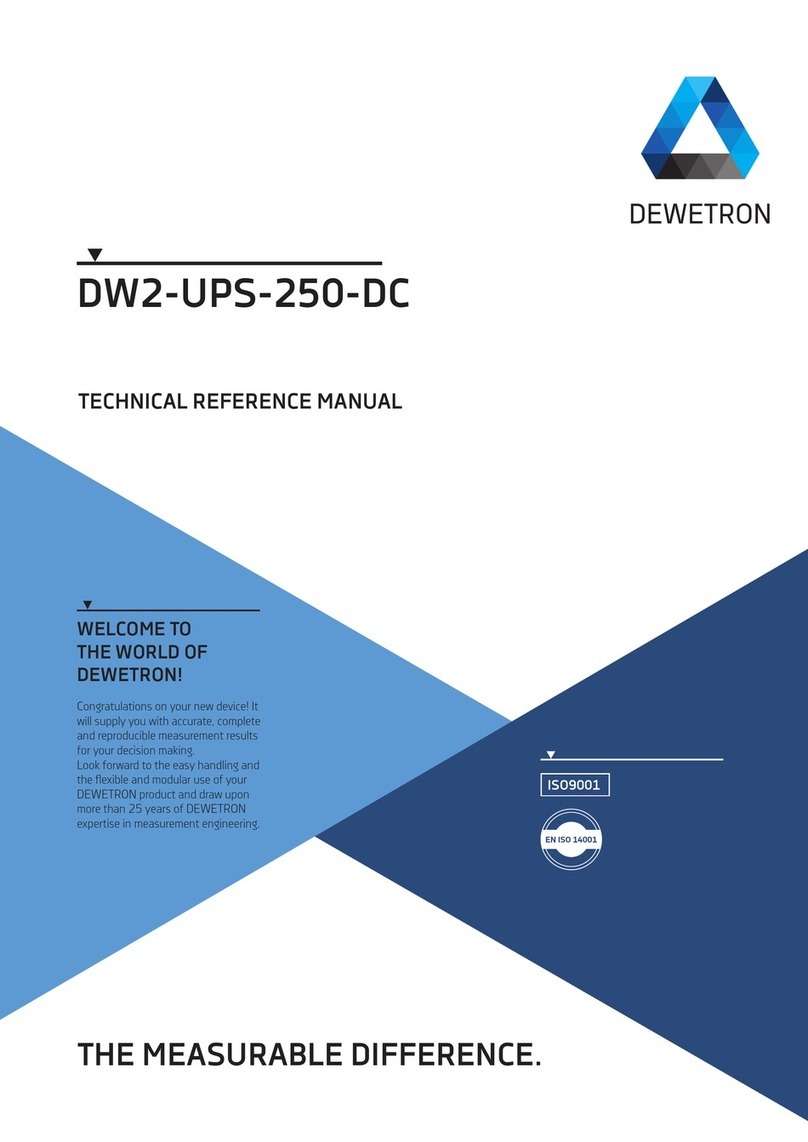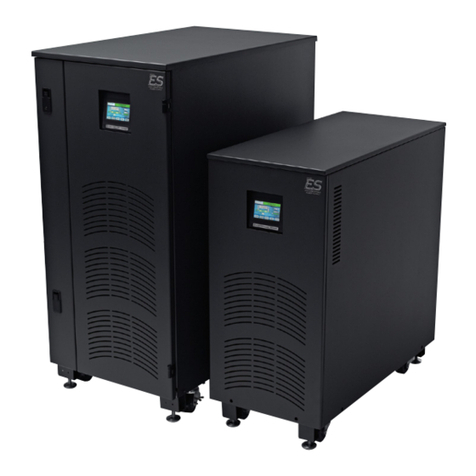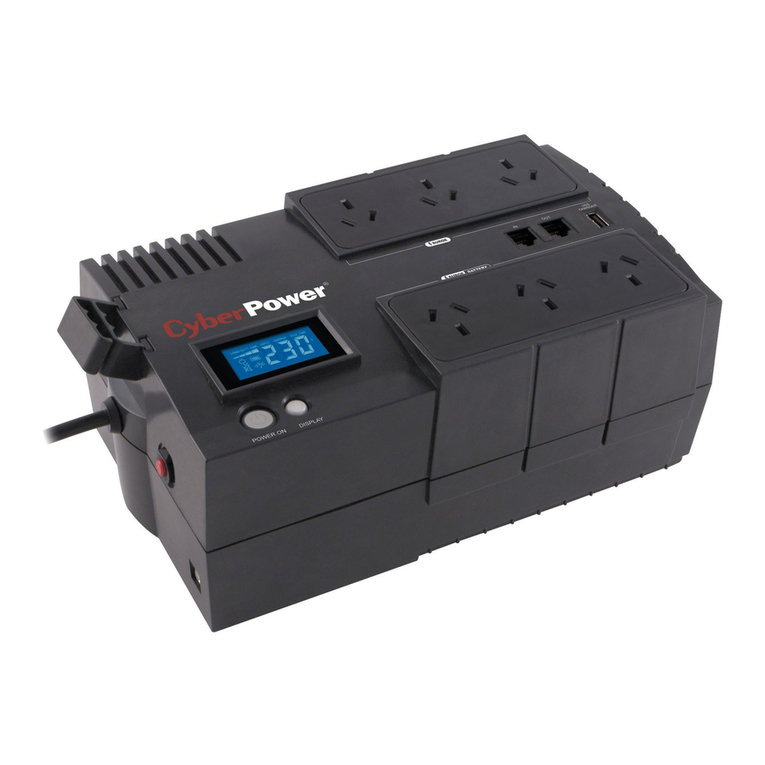Xtreme X90-2S Guide

Table of Contents
1. Safety ...............................................................................................................................3
1.1 Important Safety Instructions ........................................................................................3
1.2 EMC.............................................................................................................................3
1.3 Installation information .................................................................................................3
1.4 Maintenance.................................................................................................................5
1.5 Recycling the used battery ............................................................................................5
2. Installation ........................................................................................................................6
2.1 Initial Inspection...........................................................................................................6
2.2 Installation Environment................................................................................................6
2.3 Unpacking ....................................................................................................................7
2.4 Moving the Cabinet .......................................................................................................9
2.5 Types of UPS Cabinet .................................................................................................. 10
2.6 Exterior ...................................................................................................................... 11
2.7 Internal Mechanisms ................................................................................................... 14
2.8 Control Panel.............................................................................................................. 16
2.9 Introduction of Modules .............................................................................................. 18
2.10 Power Cable ............................................................................................................. 23
2.11 Wiring ...................................................................................................................... 23
2.12 Power Module Installation.......................................................................................... 26
3. Operation Mode and UPS Operation............................................................................... 29
3.1 Block diagram of UPS.................................................................................................. 29
3.2 Operation Mode .......................................................................................................... 30
3.3 UPS Operation ............................................................................................................ 35
4. Control Panel and Display Description................................................................................ 49
4.1 Introduction ............................................................................................................... 49
4.2 Screen Description ...................................................................................................... 50
4.3 Alarm List................................................................................................................... 73
4.4 History Record............................................................................................................ 75
5. Interface and Communication ........................................................................................... 77
5.1 Dry Contact Port ............................................................Error! Bookmark not defined.
5.2 Extra Comm. Slot...........................................................Error! Bookmark not defined.
5.3 Local Communication Ports –RS232 & USB .....................Error! Bookmark not defined.
5.4 SNMP Slot ..................................................................... Error! Bookmark not defined.
6. Troubleshooting ............................................................................................................... 77
7. Service ............................................................................................................................ 81
7.1
Replacement Procedures Of Power Module ................................................................... 81
7.2 Replacement Procedures Of Air Filter ........................................................................... 81
8. Specifications................................................................................................................... 83
8.1 Conformity And Standards....................................................................................... 83
8.2 Environmental Characteristics.................................................................................. 83
8.3 Mechanical Characteristics....................................................................................... 83
8.4 Electrical Characteristics (Input Rectifier) ..................................................................... 84
8.5 Electrical Characteristics (Intermediate DC Circuit).................................................... 84
8.6 Electrical Characteristics (Inverter Output) ............................................................... 84
8.7 Electrical Characteristics (Bypass Mains Input) ......................................................... 85

1. Safety
1.1 Important Safety Instructions
This UPS contains LETHAL VOLTAGES. All repairs and service must be performed by AUTHORIZED
SERVICE PERSONNEL ONLY. There are NO USER SERVICEABLE PARTS inside the UPS.
WARNING:
⚫The UPS is designed for commercial and industrial purpose and must not be used for any life
sustainment and support.
⚫The UPS system contains its own energy source. The output terminals may carry live voltage
even when UPS is disconnected from an AC source.
⚫To reduce the risk of fire or electrical shock, UPS installation must be in an environmentally
controlled room where temperature and humidity are monitored. Ambient temperature must
not exceed 40°C. The system is only for indoor use.
⚫Ensure all power is disconnected before installation or service.
⚫Service and maintenance should be performed by qualified personnel only.
1.2 EMC
WARNING: This is a product for commercial and industrial application in the second environment
- installation restrictions or additional measures may be needed to prevent disturbances.
1.3 Installation information
WARNING:
⚫Installation must be performed by qualified personnel only.
⚫The cabinets must be installed on a level floor suitable for computer or electronic equipment.
⚫The UPS cabinet is heavy. If unloading instructions are not closely followed, cabinet may cause
serious injury.
⚫Do not tilt the cabinets more than 10 degree.
⚫Before applying electrical power to the UPS, make sure the Ground conductor is properly
installed.
⚫Installation and Wiring must be performed in accordance with the local electrical laws and
Before working on this circuit
-Isolate Uninterruptible Power
System (UPS)
-Then check for Hazardous
Voltage between all terminals
including the protective earth.
Risk of Voltage Backfeed
The isolation device must be able to carry the UPS input current.

regulations.
⚫The disconnection device should be chosen based on the input current and should break line
and neutral conductors - four poles for three phases.

1.4 Maintenance
WARNING:
⚫Only qualified service personnel should perform the battery installation.
⚫The following PRECAUTIONS should be observed
(1.) Remove watches, rings, or other metal objects.
(2.) Use tools with insulated handles.
(3.) Wear rubber gloves and boots.
(4.) Do not lay tools or metal parts on top of batteries or battery cabinets.
(5.) Disconnect the charging source prior to connecting or disconnecting terminal.
(6.) Check if the battery is inadvertently grounded. If it is, remove the source of grounding.
Contacting with any part of the ground might result in electrical shock. The likelihood of
such shock can be prevented if such grounds are removed during installation and
maintenance.
⚫UPS is designed to supply power to the load even when disconnected from the utility power.
Only after disconnecting the utility and DC power should authorized service personnel attempt
internal access to the UPS.
⚫Do not disconnect the batteries while the UPS is in Battery mode.
⚫Disconnect the charging source prior to connecting or disconnecting terminals.
⚫Batteries can result in a risk of electrical shock or burn from high short circuit current.
⚫When replacing batteries, use the same type and number of sealed, lead-acid batteries.
⚫Do not open or mutilate the battery. Released electrolyte is harmful to the skin and eyes and
may be toxic.
1.5 Recycling the used battery
WARNING:
⚫Do not dispose of the battery in a fire. Battery may explode. Proper disposal of battery is
required. Refer to your local codes for disposal requirements.
⚫Do not open or mutilate the battery. Released electrolyte is harmful to the skin and eyes. It
may be toxic.
⚫Do not discard the UPS or the UPS batteries in the trash. This product contains sealed,
lead-acid batteries and must be disposed properly. For more information, contact your local
recycling/reuse or hazardous waste center.
⚫Do not discard waste electrical or electronic equipment (WEEE) in the trash. For proper
disposal, contact your local recycling/reuse or hazardous waste center.
CAUTION:
RISK OF EXPLOSION IF BATTERY IS REPLACED BY AN INCORRECT TYPE. DISPOSE OF USED
BATTERIES ACCORDING TO THE INSTRUCTION.

2. Installation
2.1 Initial Inspection
1. Visually examine if there is any damage inside and outside of packages in the process of the
transportation. If any damage is found, report it to the carrier immediately.
2. Verify the product label is correct.
3. If the equipment needs to be returned, carefully repack the equipment using the original
packing material.
2.2 Installation Environment
1. The UPS is designed for indoor use only and should be located in a clean environment with
adequate ventilation to keep the environmental parameters within the required specification.
2. Make sure that transportation routes (corridor, door gate, elevator, etc.) and installation area
can accommodate and bear the weight of the UPS, the external battery cabinet and handling
equipment.
3. The UPS uses forced convection cooling by internal fans. Cooling air enters through ventilation
holes on the cabinet front door and exits through the cabinet top cooling fans. Please do not
block the ventilation holes.
4. Ensure that the installation area is spacious for maintenance and ventilation.
5. Keep the temperature of installation area below 40°C and humidity within 90%. If necessary,
install a system of room extractor fans to keep temperature below 40C.
6. Air filters are necessary if the UPS operates in a dusty environment.
7. If an external battery cabinet is used, it is recommended that the external battery cabinet is
located right next to the UPS cabinet. We recommend the following clearances:
⚫Keep a clearance of 100cm from the top of the UPS for maintenance, wiring and
ventilation.
⚫Keep a clearance of 150cm from the front of the UPS and the external battery cabinets for
maintenance and ventilation.
8. For safety concerns, we suggest that you shall:
⚫Keep CO2 or dry powder fire extinguishers near the installation area.
⚫Install the UPS in an area where walls, floors and ceilings were constructed with fireproof
materials.
9. Do not allow unauthorized personnel to enter the installation area. Assign specific personnel to
keep the UPS key.

2.3 Unpacking
1. Use a forklift to move the product to installation area. Refer to Figure 2-1. Please make sure
the bearing capacity of forklift is sufficient.
2. Please follow the orders in Figure 2-2 to remove carton and foams.
Figure 2-1
]
Figure 2-2

3. Put the ramp in the front of the cabinet. Refer to Figure 2-3.
Figure 2-3
4. Remove 2 fixing cabinet plates and loosen leveling feet by rotating them counterclockwise.
Then, move the cabinet from the pallet. Refer to Figure 2-4.
5. To fix the cabinet in position, simply rotate leveling feet clockwise. Refer to Figure 2-5.
Figure 2-4
Figure 2-5
Ramp

2.4 Moving the Cabinet
The UPS is fixed on the pallet with 2 fixing cabinet plates. When removing them, pay attention
to the movement of the casters to avoid accidents.
The cabinet can be pushed forward or backward only. Pushing it sideward is not allowed.
When pushing the cabinet, pay attention not to overturn it as the gravity center is high.
1. If you need to move the UPS over a long distance, please use an appropriate equipment like a
forklift. Do not use the UPS casters to move over a long distance.
2. After the UPS has been removed from the pallet to ground, we suggest that at least three
people move the UPS to the installation area. One person holds a lateral side of the UPS with
hands; another holds the other lateral side of the UPS with hands, and the third person pushes
the UPS either from the front side or from the back side to the installation area and avoid
tipping the UPS.
3. The casters are designed to move on level ground. Do not move the UPS on an uneven surface.
This might cause damage to the casters. Toppling the UPS could also damage the unit.
4. Ensure that the weight of UPS is within the bearing capacity of any handling equipment.
5. At the bottom of the UPS, the four casters help you move the UPS to a designated area. Before
you move the UPS, please turn the four leveling feet counterclockwise to raise them off the
ground. This protects the leveling feet from being damaged.
6. To fix the cabinet in position, simply rotate leveling feet clockwise.
7. One can re-use the 2 fixing cabinet plates to fix the cabinet firmly to the ground. Refer to Figure
2-6.
Figure 2-6
Caster
Leveling foot
Fixing cabinet
plate

2.5 UPS Cabinet
Model
X90-2S
Drawing
Cabinet Height
42U
Monitor Module
1
Max. Power Module
2
Max Power
140kVA

2.6 Exterior
On the UPS front door, there are control interface (LCD Panel) and door lock.
The side panels are lockable. The casters at the bottom of the UPS cabinet can be used to move the
UPS over a short distance. There are four leveling feet to fix and stabilize the UPS cabinet on the
ground. Refer to Figure 2-7.
Inside the cabinet, there are Breakers, a Monitor Module and Power Module slots. All wiring
terminal blocks are in the front of cabinet.
Figure 2-7 Exterior

2.6.1 Mechanical Data
Dimensions
Width
Depth
Height
600mm
1065m
2010mm
Figure 2-8 Dimensions

2.6.2 Front View
Unlock and open the front door and you will see a top cover (terminal blocks are behind it), the
Main Breaker (Q1), Maintenance Breaker (Q2), Output Breaker (Q3), Monitor Module, Power
Module slots and Battery Module slots.
Figure 2-9 Front View

2.7 Internal Mechanisms
2.7.1 Breakers
There are four breakers: Main Breaker, Maintenance Breaker, Output Breaker and Battery Breaker.
Figure 2-11 breakers (front view)
2.7.2 Wiring Terminal Blocks
Open the UPS’s front door and remove the top cover, and you will see the wiring terminal blocks.
For UPS cabinet wiring, please refer to Figure 2-13.
No.
Item
Function
Description
Output Block
Connects the loads
Includes R, S, T
Bypass Input Block
Connects bypass AC source
Includes R, S, T
Main Input Block
Connects main AC source
Includes R, S, T
For UPS Grounding
For UPS grounding
Includes one grounding terminal.
Battery Input Block
Connects an external battery
cabinet
Includes
Positive (+), Negative (-) and
Neutral (N) terminals.

Figure 2-13 Terminal Blocks

2.8 Control Panel
2.8.1 LCD Display
The touch screen color LCD display shows the UPS’operation mode. In addition, a user can also
view measurement, parameters, versions of firmware, warnings and etc. on the LCD, as well as
controlling the UPS and setting various parameters. For detailed information, please refer to
Chapter 4.
Figure 2-14 Control Panel
2.8.2 LED Indicators
LED
Color
Status
Definition
LINE
Green
On
Input source is normal.
Flashing
Main Input source is abnormal.
Off
No input source
BYPASS
Yellow
On
Load on Bypass
Flashing
Bypass Input source is abnormal.
Off
Bypass circuit is not operating.
LOAD
Green
On
The UPS is outputting power to the load.
Off
The UPS is not outputting power to the load.
INV
Green
On
Load on inverters
Off
Inverter circuit is not operating.
BATTERY
Red
On
UPS is in battery mode.
Flashing
Battery voltage is low.
Off
UPS isn’t in battery mode and battery is fully charged.
FAULT/
ALARM
Red
On
UPS fault
Flashing
UPS alarm

Off
There is neither a fault nor an alarm.

2.8.3 Control Key
Turn on or turn off the UPS.
2.9 Introduction of Modules
The modular and hot-swappable design of the Power Module makes it a highly cost-effective
solution to meet your power requirement. The number of Power Modules installed in the UPS can
be based on the initial needs. Once the power requirement changes, you can easily change the
number of Power Modules without interrupting the operation of the system.
Figure 2-15 Front View

2.9.1 Monitor Module
The Monitor Module is installed at factory, which includes communication interfaces. For detailed
information, please refer to Chapter 5.
No.
Item
Description
①
SNMP Slot
An optional card such as an SNMP, AS400 or Modbus card can be
inserted into this slot.
②
Extra Comm. Slot
An optional Extra Comm. Card can be inserted into this slot. This card
can enhance the communication capability of the UPS system and
provide another SNMP slot and some dry contact ports.
③
Dry contact ports
CN1 ~ CN8. For detailed information, please refer to Chapter 5.
④
⑤
⑥
LCD Port
This port connects to Control Panel by a cable installed at factory.
⑦
RS232 port
Local communication interface.
⑧
USB port
Local communication interface.
⑨
LED
Power light
Figure 2-16 Monitor Module

2.9.2 Power Module
Each Power Module is shipped in its own package and installed during the UPS system installation.
The capacity of each Power Module is 50KVA/50KW or 70kVA/70kW. It includes a power factor
correction rectifier, a battery charger, an inverter, STS and control circuit.
No.
Item
Description
Fan
These fans provide forced convection cooling. Cooling air enters the
module through ventilation grills in front of the fans and exits through
grills located in the rear of the module. Do not block the ventilation area.
Ready Switch
Unlock it before removing the Power Module.
Lock it when the Power Module is well installed. Then the Power Module
can start to work.
DIP Switches
There are five DIP switches for Power Module address ID setting. In the
same cabinet, each Power Module ID MUST be exclusive. The setting
method is shown in Table 2-1.
Battery Start
Button
When AC input is not available, use this button to start the UPS with
battery power.
FAULT LED
ON
The Power Module is in fault condition, or the Ready
Switch is unlocked.
ON/OFF 0.5 sec
The Power Module ID is set to the same as another
Power Module in the system (IDs conflict).
RUN LED
ON
The Power Module works normally as a slave
module.
RUN LED
ON/OFF 0.5 sec
The Power Module works normally as a master
module.
ON/OFF 0.15 sec
CAN Bus communication fails.
Figure 2-17 Power Module
Table of contents
Other Xtreme UPS manuals

